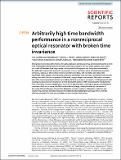Files in this item
Arbitrarily high time bandwidth performance in a nonreciprocal optical resonator with broken time invariance
Item metadata
| dc.contributor.author | Cardea, Ivan | |
| dc.contributor.author | Grassani, Davide | |
| dc.contributor.author | Fabbri, Simon | |
| dc.contributor.author | Upham, Jeremy | |
| dc.contributor.author | Boyd, Robert | |
| dc.contributor.author | Altug, Hatice | |
| dc.contributor.author | Schulz, Sebastian Andreas | |
| dc.contributor.author | Tsakmakidis, Kosmas | |
| dc.contributor.author | Brès, Camille-Sophie | |
| dc.date.accessioned | 2020-10-07T16:30:01Z | |
| dc.date.available | 2020-10-07T16:30:01Z | |
| dc.date.issued | 2020-09-25 | |
| dc.identifier | 270187979 | |
| dc.identifier | 9dd8e15f-a2fd-4306-81d7-dc5fe56ec8f2 | |
| dc.identifier | 85091535743 | |
| dc.identifier | 000577248100027 | |
| dc.identifier.citation | Cardea , I , Grassani , D , Fabbri , S , Upham , J , Boyd , R , Altug , H , Schulz , S A , Tsakmakidis , K & Brès , C-S 2020 , ' Arbitrarily high time bandwidth performance in a nonreciprocal optical resonator with broken time invariance ' , Scientific Reports , vol. 10 , 15752 . https://doi.org/10.1038/s41598-020-72591-6 | en |
| dc.identifier.issn | 2045-2322 | |
| dc.identifier.other | ORCID: /0000-0001-5169-0337/work/81797601 | |
| dc.identifier.uri | https://hdl.handle.net/10023/20738 | |
| dc.description.abstract | Most present-day resonant systems, throughout physics and engineering, are characterized by a strict time-reversal symmetry between the rates of energy coupled in and out of the system, which leads to a trade-off between how long a wave can be stored in the system and the system’s bandwidth. Any attempt to reduce the losses of the resonant system, and hence store a (mechanical, acoustic, electronic, optical, or of any other nature) wave for more time, will inevitably also reduce the bandwidth of the system. Until recently, this time-bandwidth limit has been considered fundamental, arising from basic Fourier reciprocity. In this work, using a simple macroscopic, fiber-optic resonator where the nonreciprocity is induced by breaking its time-invariance, we report, in full agreement with accompanying numerical simulations, a time-bandwidth product (TBP) exceeding the ‘fundamental’ limit of ordinary resonant systems by a factor of 30. We show that, although in practice experimental constraints limit our scheme, the TBP can be arbitrarily large, simply dictated by the finesse of the cavity. Our results open the path for designing resonant systems, ubiquitous in physics and engineering, that can simultaneously be broadband and possessing long storage times, thereby offering a potential for new functionalities in wave-matter interactions. | |
| dc.format.extent | 8 | |
| dc.format.extent | 3188521 | |
| dc.language.iso | eng | |
| dc.relation.ispartof | Scientific Reports | en |
| dc.subject | QC Physics | en |
| dc.subject | TK Electrical engineering. Electronics Nuclear engineering | en |
| dc.subject | NDAS | en |
| dc.subject.lcc | QC | en |
| dc.subject.lcc | TK | en |
| dc.title | Arbitrarily high time bandwidth performance in a nonreciprocal optical resonator with broken time invariance | en |
| dc.type | Journal article | en |
| dc.contributor.institution | University of St Andrews. School of Physics and Astronomy | en |
| dc.identifier.doi | https://doi.org/10.1038/s41598-020-72591-6 | |
| dc.description.status | Peer reviewed | en |
This item appears in the following Collection(s)
Items in the St Andrews Research Repository are protected by copyright, with all rights reserved, unless otherwise indicated.

